Sunday 20th September 2020
London Open House this year was obviously affected by you-know-what and as part of that published a number of self-guided tours which you could (and at the time of writing still can) download and follow at your own pace and at your own time. So as it was reasonably easy to get to and looked interesting I picked the Hammersmith & Fulham route for a Sunday afternoon explore.
| Hammersmith & Fulham Self Guided Walk Along the route of the self-guided walk by Open House London 2020. open-city.org.uk/selfguided-tours |
||
 |
Stamford Brook Tube Station (District Line), W6 0SB The District Railway has operated through here since 1869, but this station was only built in 1912. The tracks were doubled in the 1930s to accommodate the extension of the Piccadilly Line. London’s first automatic ticket barrier was installed here in January 1964. Out of the Oyster gate, de-mask, and cross the road and turn right, then left into King Street and right into St. Peter's Church. | |
 |
St. Peter's Square. The first houses to be built in the square were on the northern side, with the whole square complete by 1830. The statue in the middle of the garden, erected in 1926, is The Greek Runner, by Sir William Blake Richmond who lived locally. He also designed the mosaics in St Paul’s Cathedral. | |
 |
Having walked south through the gardens at an appropriate social distance from the picnickers I emerged into the street and turned left towards the church. | |
 |
St Peter’s Church (Edward Lapidge) is in Ionic style with an impressive set of columns. I cut south through Verbena Gardens to the A4 Great west Road. | |
 |
Right next to the A4 is a cast concrete statue: “Draped Woman”, by Karel Vogel. Studio magazine said in 1962 that it “expresses his intention in a floating movement, repeating the curve of the road and taking up the slope of the opposite subway”. If you say so. I passed under the busy A4 via the subway into South Black Lion Lane. | |
 |
On the left is the Black Lion pub which was doing a good Sunday lunch trade. Further down the lane, at the Thames, are Bell Steps: Here, Frederick Bell ran a ferry across the Thames (which is tidal down to Richmond). | |
 |
To the right of Bell Steps is Hammersmith Terrace. One of the houses has a blue plaque commemorating Edward Johnston, CBE (11 February 1872 – 26 November 1944), the British craftsman and calligrapher most famous for designing the sans-serif Johnston typeface that was used throughout the London Underground system until it was redesigned in the 1980s. He also redesigned the famous roundel symbol used throughout the system. | |
 |
From Bell Steps I turned left to follow Upper Mall alongside the Thames. The Old Ship Inn on Upper Mall dates from about 1722 and was also making the most of the sunshine before our PM decided to scapegoat pubs for the increase in Covid19 infections. | |
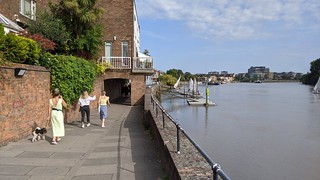 |
Following Upper Mall the footpath passes under the first floor of some 1960s houses which front onto Oil Mill Lane and back right onto the river. | |
 |
Further along Linden House which dates back to the 18th century and is the headquarters of the London Corinthian Sailing Club. It has a prominent flagpole (mast?) and apparently a problem with bicycle thieves. | |
 |
On the river side of the path is London Corinthian Sailing Club's race starting box, which won a Civic Trust award in 1964. | |
 |
At the junction of Upper Mall and Weltje Road is a blue plaque commemorating locally born artist, Eric Ravilious who lived at 48 Upper Mall in the 1930s. | |
 |
A number of the buildings along the next stretch of Upper Mall are used by Latymer School, including Rivercourt House. Also a man having a fight setting his motorcycle alarm, with the number of people walking, scooting, and cycling along here it was anything but peaceful. | |
 |
Amongst the older mostly brick-built houses No.28, the lower building on the left of the picture is one of the few modern buildings on Upper Mall. | |
 |
Where the road narrows to challenging social distancing width is the Dove pub at 19 Upper Mall. The pub, owned by Fullers since 1796, has one of the smallest bars in England. There is a terrace overlooking the Thames. | |
 |
Beyond the pub lies Dove Pier at the corner of Furnivall Gardens where there are houseboats moored at the pier and along the riverbank. | |
 |
Furnivall gardens were established after WW2 on the site of rundown industrial buildings and Hammersmith Creek, which was filled in in 1936. Stamford Brook reached the Thames here, and barges docked along the creek right up to King Street. There was too long a queue for the ice cream van unfortunately. The gardens are a popular place to watch boat races in years when that is allowed. | |
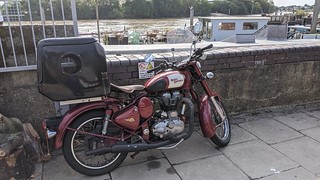 |
From India to Fulham. With added pet carrier. For cat or dog (or maybe just pizza) I don't know. | |
 |
The first house after Furnivall Gardens is Westcott Lodge, set back slightly from Lower Mall. Previously the vicarage of St Paul’s Hammersmith, which is just the other side of the flyover and which the walk passes later on. | |
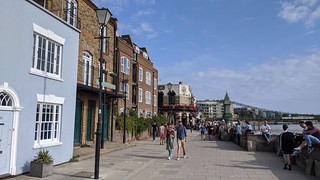  |
The next stretch of Lower Mall was fairly busy. Here is Furnivall Sculling Club Dr Frederick Furnivall (who originated the Oxford English Dictionary) founded The Furnivall Sculling Club for girls in 1896. Men could join from 1901. On the corner of Mall Road are two pubs with a rowing club between them: The Rutland Arms (1870, lost its top floor in WW2), Auriol Kensington Rowing Club (formed by amalgamation in 1981), and The Blue Anchor (licensed from 1722, and one of the oldest pubs in London). In another time I'd have been tempted to stop for a pint. | |
  |
The previous photo was taken with my back to Hammersmith Bridge. Hammersmith Bridge is unwell. Designed by Sir Joseph Bazalgette and opened in 1887, replacing an earlier bridge built in 1827. It has frequently been repaired and is currently closed to all traffic including pedestrians, awaiting further extensive repairs. The towpath under the bridge is closed and river traffic is not allwed to pass under it due to the dangerous state of the structure. The coats of arms displayed at on the suspension stays at both ends of the bridge (and overpainted in green paint) are those of the City of London, Kent, Guildford, City of Westminster, Colchester, Middlesex and, in the centre, the United Kingdom | |
 |
The walking route was intended to pass under the bridge but with the path closed I had to make a short diversion up Hammersmith Bridge Road and back. This disused drinking fountain on the west side of the bridge abutment wall would have remained unseen had the path below the bridge been open. | |
 |
Beyond the bridge and rejoining the riverside the next point of interest is Riverside Studios The site was redeveloped and re-opened as an arts centre with 165 flats above and around it (Assael Architecture) in 2019. It had been a film and BBC television studio since 1933. Amongst the first programmes made there was Hancock's Half Hour, as the show demanded a studio audience which Riverside could accommodate. During the 1950s and 60s it was the recording location for some famous programmes, including the science-fiction classic Quatermass and the Pit, early episodes of Doctor Who, and children's favourite Play School. The new building however lacks either round or arched windows to look through. | |
   |
I turned away from the river (or rather I should have done but didn't and had to retrace my steps for a bit) up Queen Caroline Street, named after the unhappy wife of George IV who lived in and had her rival court in Hammersmith. Along Queen Caroline Street are apartment blocks from three different eras, including a Peabody Trust estate. | |
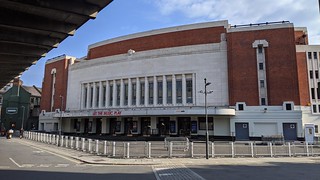 |
At the top of Queen Caroline Street on the right and facing the flyover is the Hammersmith Apollo (now called Eventim Apollo). Designed by Robert Cromie in Art Deco style, it opened in 1932 as the Gaumont Palace, being renamed the Hammersmith Odeon in 1962, and became an important live music venue, featuring Buddy Holly, Miles Davis, Riverdance and SpongeBob SquarePants, among many others. The 1932 pipe organ was restored in 2007, and the building was refurbished by architects Foster Wilson in 2013. | |
 |
It's impossible to miss the Hammersmith Flyover. Although I've driven over it many times I'd never stood under it before today. The flyover was designed by G. Maunsell & Partners, and completed in 1961. It speeds up traffic from Earls Court to the Great West Road. It needed remedial work between 2010 and 2015, with weight restrictions on vehicles using it during that time. | |
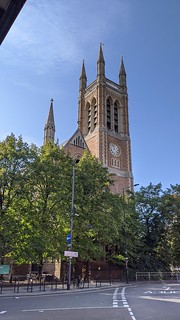 |
Right next to the flyover is St. Peter's Church. The church is designed in the Early English Gothic Style, with lancet windows, powerful buttresses, a high roof and an imposing tower.In July 1882 the Duke of Albany laid the foundation stone, and the nave of the new church was consecrated on 13 October 1883. The architects were J. P. Seddon and H. R. Gough. Like St Peter's Church in Hammersmith, St Paul's lost a significant portion of its land, including that with graves, when Hammersmith Flyover, which can just been seen at top left of the picture, was built. | |
 |
Across from the church is the end of the walk at Hammersmith tube station (District and Piccadilly lines). Parts of the old facade of the original station were re-used in the design of the interior of the station’s new north ticket hall, which was rebuilt in the 1990s by Minale Tattersfield. This though is the south entrance in the shadow of the flyover which handily leads through the small shopping centre where I puchased a late lunch and headed back down to the river to eat it before carrying on to Putney Bridge because it was only twenty to four and such a nice day for a riverside stroll. | |
Much of the information in this post was taken from the Open City downloadable PDF but I've added to it where some features weren't mentioned.
And just for giggles I've plotted the route on this Google Map
